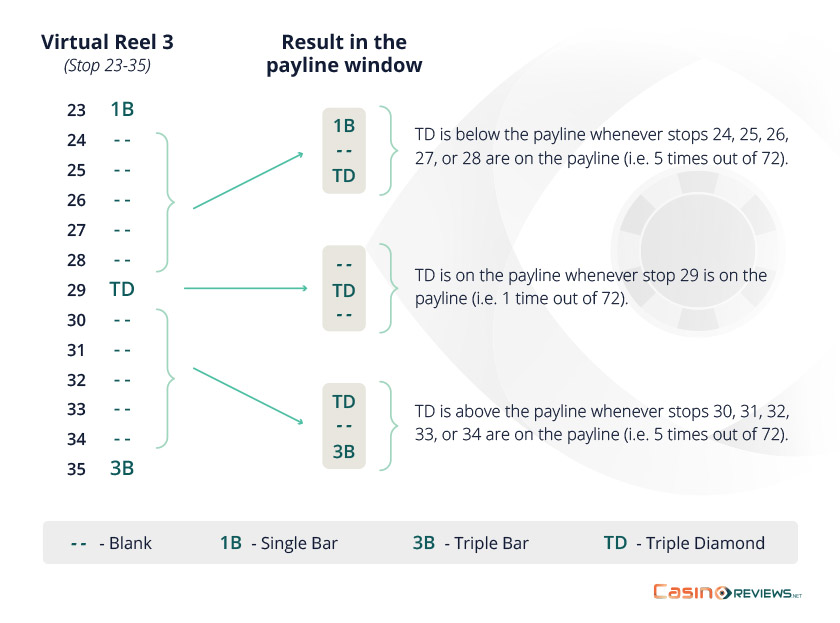Near-Miss Effect in Slot Machines

The near miss phenomenon—a failure that looks close to being successful—occurs in every game of chance; however, some slots games have generated most of the discussions among theorists and researchers about the causes, effects, and ethical and legal aspects of the near miss. The reason for this resides in the design of the slots game, which allows the manipulation of the game parameters so as to result in more frequent outcomes looking like near misses and interpreted by players as chance near misses. They are what we call artificial or engineered near misses.
Engineered Near Misses within and outside the Paylines
A near miss is a non-winning outcome differing in one or more elements from a winning one. For instance, an outcome holding 3 award symbols on a payline needing four such symbols to be a winning outcome is a near miss and is perceived by the player as such in what psychologists call the near miss effect.

However, for the game of slots displaying grids of more than 1 row, the near miss and the near miss effect can also be related to elements outside the actual outcome—that is, symbols occurring on the display as adjacent to the payline (below or above the payline or to the left or right of it). For instance, if a missing winning symbol on a payline is displayed right above the spot where it was expected, this extended outcome may be called a near miss and perceived as a near miss by the player. The winning combination was missed on that payline, and that miss has nothing to do with what occurred beyond it, but the fact is that it has, and this dependence is determined prior to the occurrence by the game’s design.

By manipulating the mathematical design of a game in what concerns the symbol weighting of the reels, the arrangement of the symbols on the reels, and the mapping from virtual to physical reels, the developers can cause such engineered near misses to be frequent. Of course, their aim is to reach an effect that the near miss has for the players, namely, that of continued play under the illusion that they are close to a win.
Techniques for Engineered Near Misses
The apparent near miss can be engineered to occur frequently either on the payline, by choosing the right weightings for each reel, or adjacent to the payline. In the latter case, the premise is that the display or window shows not only the stop of the reel with the actual outcome but also a portion of the reel neighboring it (for old classical slots, there are 3 such visible stops in the window).
For instance, on a 3-reel machine, a symbol that forms a high prize combination in triple instances (1 on each reel) is weighted in a high ratio on 2 of the reels and in a very low one on the third. As such, it will occur frequently on the reels where it is highly instantiated, creating a false near miss. This technique is sometimes called the award symbol ratio.
As for the engineered near misses adjacent to the payline, they were also devised in old classical physical-reel machines in a trivial way by arranging the symbols on the reel strip such that an awarding symbol will be adjacent to a non-awarding one. In this way, when a non-awarding symbol occurs on a reel, an awarding one is frequently visible in the payline window right above or below it.
For modern slots, the technique creating false near misses adjacent to the payline is called clustering and relies on the flexibility of the symbol weighting and arrangement on the virtual reels. The basic idea is to place a stop with a high-award symbol on the virtual reel between several stops with low-award symbols or blanks, mapped into the corresponding positions on the physical reel or the virtual reel visible in the payline window. Next is a simple example of how clustering works in a real slots game.
Example of the Clustering Technique
In the next figure is a portion of an actual 72-stop virtual reel. The physical (visible) reel has 22 stops, half of which are blanks. TD is the highest paying symbol. The portion of the visible reel holding the TD symbol is 1B ˗ ˗ TD ˗ ˗ 3B (the symbols are described in the figure’s legend). TD is placed in virtual stop 29 and has 5 blanks above it (virtual stops 24–28) and 5 blanks below it (virtual stops 30–34) on the virtual reel.

Each stop on the virtual reel will occur on the payline, on average, 1 time out of 72. Thus, each of the 5 blanks in positions 24–28 will occur, on average, on the payline 1 time out of 72 for a total of 5 times. Because the 5 blanks 24–28 are adjacent to the TD, it follows that the TD in position 29 will be just below the payline on the visible reel, on average, 5 times out of 72.
The TD in position 29 will occur on the payline, on average, 1 time out of 72 and as frequently on the visible reel. The 5 blanks in positions 30–34 will each occur on the payline, on average, 1 time out of 72 for a total of 5 times. Because the 5 blanks 30–34 are adjacent to the TD, the TD in position 29 will be just above the payline, on average, 5 times out of 72.
If the visible reel were to determine the outcome by a random spin, the positions creating (by chance) near misses for TD as shown in the figure would have occurred, on average, 2 times out of 22 (stops)—that is, 1 time out of 11. Because of the mapping from the virtual reel, those positions will actually occur, on average, 10 times out of 72 (virtual stops)—that is, 1 time out of 7.2. Therefore, the frequency of those positions has been increased artificially with the clustering technique.
There are only 11 blanks on the physical reel, but the chances that the RNG will pick a blank are much higher than 1 in 11. In fact, the blanks immediately above and below the high-award symbol are favored on the physical reel. Hitting these blanks gives players the illusion that they almost landed the high-award symbol because that symbol is physically close to the payline, but it is not mathematically close.
The techniques of creating false near misses in slots are quite complex, and I have limited the presentation to a short description and simple example just to illustrate the essentials of these engineered near misses.
Resisting the Near Miss Effect and Other False Illusions in Slots
The general expert’s advice against the near miss effect is not to mentally split the actual outcome into matching and non-matching parts and to treat it like any other non-winning outcome. In slots, this advice applies to the near misses on a payline. To cover the near misses adjacent to the payline as well, this advice extends to say that the entire display should not be considered as an outcome; in other words, one should not search for matching parts outside the payline, which is the only place where the real outcomes occur.
Another engineered add-on to modern slots is a “stop” button. By pressing the stop button, the player apparently chooses the time when the reels stop spinning and display the outcome. The moment of pushing the stop button is sometimes followed by a short, seemingly decelerated motion of the reels until the stop.
Many players believe that the stop button influences where the reels stop, with some even expressing the belief that there is actually a skill to using the stop button. Presumably, such skill involves the erroneous perception that by pressing the stop button at just the right time, the reels could be made to stop over winning outcomes, as if the player can actually control the occurrence of the outcome. This perception is potentiated by the visual effect of decelerating motion, and some experts argue that near misses themselves (of both previous plays and the actual play) are another factor that potentiates it.
The functionality of the modern slot machines clearly indicates that the software-based random generation of outcomes on electronic virtual reels has nothing to do with any physical or apparent physical motion and other changes of state of the display preceding the actual outcome. The RNG has already selected the number providing the outcome of the game right before the spin or before the stop by a button, and actually, that moment does not even count since there is no such thing as “stopping the spin” as long as the reels do not spin physically and the apparent stop is not associated with the RNG output.
Risks and Ethical Aspects
The near miss effect and the illusion of control in slots, as gambling-specific cognitive distortions, are considered by problem-gambling experts as important risk factors in the development of problematic gambling behavior. Once a gambler comes to know the essentials about them, that risk is diminished. The mathematics of slots is actively present in the content of this knowledge: the creation of engineered near misses follows a simple form of mathematics used by slots designers (but not easily applied) concerning the parametric manipulation of the weighting of the reels and the mapping between virtual and visible reels.
It is, of course, debatable whether the techniques of creating engineered near misses break any norms relative to both gambling legislation and the general ethics of gambling. This issue adds to the issue of the secrecy of the PAR sheets, holding the parametric configuration of a slots game. Anyway, players got so used to seeing engineered near misses in slots (whether they were aware of them or not) that such a feature of slots came to be perceived as normal and specific for the game. Perhaps only the very early versions of mechanical slots (Liberty Bell and the next few followers) were free of engineered near misses (I am not sure about this, but I will investigate).
References
Bărboianu, C. (2022). Understanding Your Game: A Mathematician’s Advice for Rational and Safe Gambling. Târgu Jiu: PhilScience Press.
Harrigan, K. A. (2008). Slot Machine Structural Characteristics: Creating Near Misses Using High Award Symbol Ratios. International Journal of Mental Health and Addiction, Vol. 6, 353–368.
Turner, N. E., & Horbay, R. (2004). How do slot machines and other electronic gambling machines really work? Journal of Gambling Issues, Vol. 11.





Review this Blog
Leave a Comment
User Comments
comments for Near-Miss Effect in Slot Machines